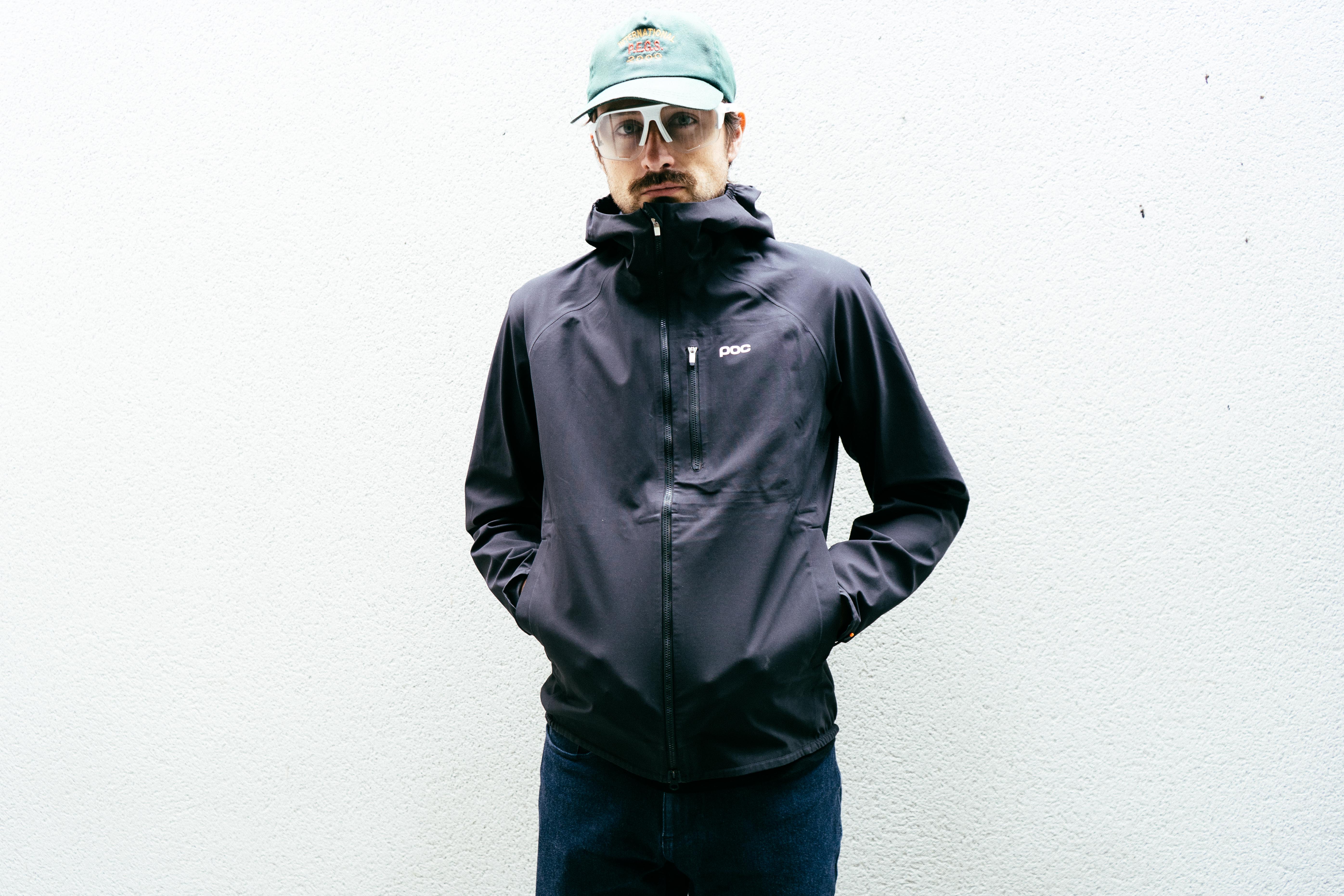
When I test waterproof jackets - and I've tried 40 or 50 of them at this point in order to distil the market down into my guide to the best waterproof cycling jackets - they all get tested in parallel initially, and then I can hone in on them individually after that. Following testing and reviewing most tend to live in a box mentally labelled ‘for reference’ unless they perform very poorly.
Some are good enough to stay in constant use because they work so well as performance garments, like the Maap Atmos and the Rapha Pro Team Gore-Tex, and some stay in constant use because they transcend the cycling jacket part of the Venn diagram and bleed into general use. The POC Motion is very much in this second camp.
I’ve been using it whenever the need arises for well over a year now and I think it’s the best option for those of you after a commuter jacket. There are a load more options in my sister guide to the best commuter cycling jackets if this doesn’t fit the bill for you, but I’m going to try and convince you that it probably does.
Now, just to be clear, if you’re commuting on a road bike then this isn’t for you. Buy a road jacket, but make it a sturdy one. The Endura Pro SL Waterproof Shell is a great option for those after a road fit, but for those not bombing to work in the drops the Motion is my pick.


Design and aesthetics
Of all the jackets I’ve reviewed in recent years the POC Motion is the one that is the most ‘normal’. On the face of it, you’d be hard-pressed to pick it out as a cycling jacket in a lineup of more general-use waterproofs. The tail is only marginally dropped, and save for a couple of little reflective patches on the rear it’s very much standard fare. Well executed for sure, but no funny business.
When I compare it to something like the Albion Zoa Rain Shell, another jacket I often reach for when I need to pop to Lidl to buy milk in the rain, it’s quite different. No voluminous hood, no heavily vented pockets, no adjustable cuffs. Just a small hood that can fit under a helmet, two moderate-sized side pockets and a chest one for valuables.
Look under the arms and you see perforated pits, much like you get on the Albion Ultralight Insulated Jacket I reviewed recently. A double zip also helps when things get toasty, and is very much a prerequisite for any outer layer for me nowadays. The cuffs are shaped so they cover more of the back of your hands. The arms are a little shorter than some jackets I’ve tried, but for riding more upright bikes this is no bad thing. I also have very gangly arms, so It’s not the fairest test.
The hood has no peak, but the brim is elasticated, meaning it sits close around the face when in use, and doesn’t act as a wind sock when not deployed. Normally I’m a fan of a hood that goes over the helmet, but in this case, I think this makes more sense.
Under the hood, so to speak, you get a very durable feeling outer fabric protected by a PFC-Free DWR treatment, and itself protecting a 20,000mm rated waterproof membrane. This is plenty for even heavy rain, and while it isn’t going to challenge the likes of the Rapha Pro Team Gore-Tex on paper, it is certainly more than adequate for non-performance riding.



Performance
On paper, the Motion is a bit of an odd jacket to give the nod to for best overall for a category. No adjustment to speak of, no mega ventilation, and a relatively standard cut. Why, then, do I think it’s the best?
First up is durability. It’s a really solid jacket, and the lack of tabs, toggles, added zips and velcro is actually advantageous in a commuter jacket. I may get a bit of flack for this but I think commuting is harder on waterproof jackets than any other kind of riding. Most people will be rocking a cycling backpack of some sort which adds wear to the back and shoulders, they get stuffed into bags with reckless abandon, and left wet on the back of office chairs - I’ve lost count of the number of times I’ve looked down to find I’ve been running my jacket over with my office chair - roasted in drying cabinets, and crashed in with greater regularity. Zips and toggles almost always give up at some point, so doing without them is handy.
The outer fabric of the Motion is especially solid, and while it isn’t the most breathable jacket it’s fine for shorter or less intense commutes and will withstand all the regular wear and tear. The hood too is great. No windsock effect when it’s down, and while I do like my hood to go over my helmet, for short journeys like a commute you’re probably going to decide at your door whether you need it up or down and it’ll be grand for the entire journey. The sleeves really are a bit short for riding in a road position, but for any flat bar bike (fixie kids I’m looking at you here) they’re perfect, and neither too tight nor too loose, so there’s room for big gloves underneath.
The other reason is that, on the whole, most commuter jackets look a bit naff. Off the bike, they instantly mark you out as a cyclist, and while there isn’t anything wrong with that I don’t want to look like I’m mid-commute at the after-work drinks, or if I throw it on to go wander around town. The Motion works really well on the bike, and I’d even say it has a place as an MTB crossover jacket too. It’s protective, and while it doesn’t have a waterproof zip for some mad reason the internal storm flap does the job, and is even stitched over on itself to stop it snagging. Off the bike, it just looks like a really good looking shell jacket, which I think is why I reach for it so often.
I’ll admit that black is perhaps not the best option for visibility, but it’s what I like because it goes with my other clothes. The other mineral-named colour options (dioptase blue and calcite blue) are very handsome too in a muted Scandi way. If you want visibility then you should focus on getting the best bike lights first, then worry about your layers as no amount of bright yellow will help if you’re running a tea light to be seen.
Breathability is often the downfall of commuter jackets. They tend to be cheaper than their road or gravel oriented siblings, and that tends to come with less breathable membranes. Again, the motion isn’t going to match jackets designed for road riding, but unless you’re absolutely hammering your ride to work it’s pretty good. The pit perforations I tend to think of as nice but not that useful, but the bottom zip does mean you can dump heat pretty effectively, and is far better than undoing the jacket from the top if you’re wearing a chest strap on your backpack.
The looser fit allows a great deal of airflow too, but also room for layering. If you commute in the cold - bear in mind POC is a Swedish brand so it knows about proper winter - a mini down jacket can easily be accommodated underneath, keeping it useable year-round.


Value
Much like the Albion Zoa the value proposition here is greatly enhanced by its off-bike credentials. If you can find it on sale - at the time of writing I’ve seen the Dioptase Blue model down to £154 - it’s an absolute bargain.
Commuter jackets in general are pretty cheap, mostly because people seem to loathe spending a lot of money on something ‘just’ for riding to and from work. The POC Motion is more expensive than many commuter jackets on the market, but I’d wager it’s a tonne more useful too, and as such I think it represents pretty great value.
Verdict
The POC Motion is a winner on the bike, as long as your commuting isn’t too intense or on a bike with a very aggressive fit. It's durable enough to withstand daily abuse, backpack-wearing, and bag-stuffing, but it’s the off-bike versatility that sets it apart from the crowd. Commuting doesn’t have to be a choice between being a fashion disaster and performance, and for a bit more cash you can have a jacket that’ll see use around town whether you’re on the bike or not.







